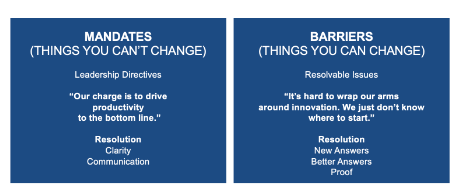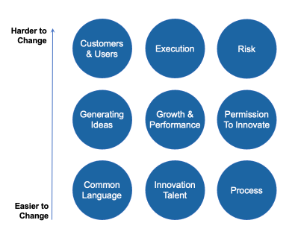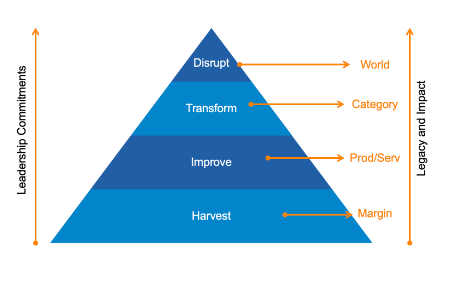
Steering around Organizational Roadblocks to Innovation: Are Your Leadership Mandates Clear?
When starting innovation, it is often best to begin by gaining an understanding of what roadblocks exist in your organization today. We have two ways to classify roadblocks: (1) some roadblocks are mandates. These are things you can’t change. And, (2) others are barriers. These are things you can change.
Mandates and Barriers
Mandates take the form of leadership directives, whether they are spoken or unspoken. An example is the statement, “Our charge is to drive productivity to the bottom line.” Although it might not be 100% clear, this statement declares that this organization’s focus is on incremental innovations. It does not care to disrupt the world, and we can determine that the appetite for innovation is very limited.
Barriers, on the other hand, are resolvable issues. An example is this statement: “It’s hard to wrap our arms around innovation. We just don’t know where to start.” This is something that can be resolved with new answers, better answers, or proof based on the unique situation leading to the issue. As the bubble graphic here shows, there are nine major categories of barriers for innovation: some easier to manipulate, and others are much harder to transform. The good news for barriers is that they can be assessed, analyzed, and mitigated.

Clarity and Communication
The best resolution for mandates is clarity and communication. You need to get clarity on what leaders mean in their statements, and provide them with examples and be sure everyone is on the same page. Then, communicate that mandate widely and clearly.
The goal of a strong innovation process is to equip you with new answers and proof points to help you resolve barriers and achieve sustainable and substantial growth.
Going deeper, in order to understand leadership mandates, you must have clarity on what your leadership’s commitment to innovation is. With this understanding, you will know how far you can go with your innovation strategy. And this hierarchy helps you understand the different mandate possibilities and their impact on innovation.

Leadership Commitments, Legacies, and Impacts
Most leaders have a low commitment to innovation and are primarily interested in harvesting and protecting the products and services the organization provides today. This means you are pretty much allowed to innovate at the margin level (e.g., operations) but not much further. The legacy and impact of these types of leaders on the world is pretty minimal.
As we go up the pyramid in this illustration below, the leadership commitment to innovation increases, as does the leader’s potential to leave a legacy and a lasting impact. However, there are fewer leaders open to these increasing levels of commitment. Let’s take a closer look at the key takeaways from this graphic:
- Leaders who are focused on improvements allow innovation at the product and service level. As such, these leaders are most open to innovation that makes better versions of what already exists.
- The leaders who are committed to transformation allow innovation at the category level. These leaders are open to changing their industry and the way things are done. And these leaders are open to big ideas.
- At the top of the pyramid are leaders who are committed to disruption. These leaders want to change the world and the ways things are done, no matter the industry. Additionally, we know that these leaders are very open to big ideas and do not have much tolerance for small ideas.
- Leaders with the highest levels of commitment to innovation will, of course, leave behind the largest legacy and impact since they are open to not only disrupt the industry, but also the world.

Conclusion
Keep in mind that each of these approaches is legitimate. Not every leader is equipped for disruptive change. But, by understanding where your leadership falls on the innovation spectrum, you will have a clearer idea of what kind of innovation strategy you’ll have license to pursue moving forward.
All Aboard
Ready to learn more about steering around organizational roadblocks and how Teaming Worldwide can help you solve your business’s most pressing innovation pain points? Let’s connect.
Intentional Innovation® Powered by Teaming Worldwide
Intentional Innovation® is a commercially-proven innovation operating system designed to simplify and implement higher-performing, longer-lasting solutions that drive market disruption, new revenue, and deeper customer engagement.
Ready to learn more about Intentional Innovation® and how Teaming Worldwide can help you solve your business’s most pressing innovation pain points? Let’s connect. Visit www.teamingworldwide.com/innovation to schedule a discovery call or email hello@teamingworldwide.com.



